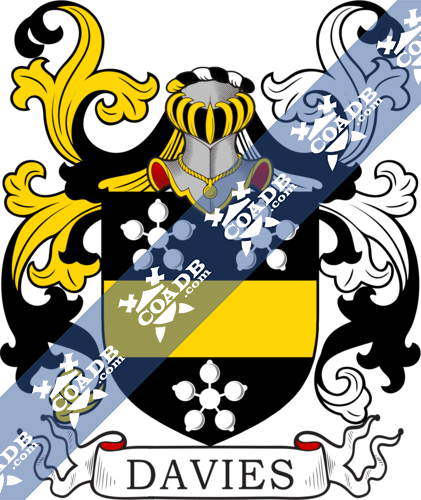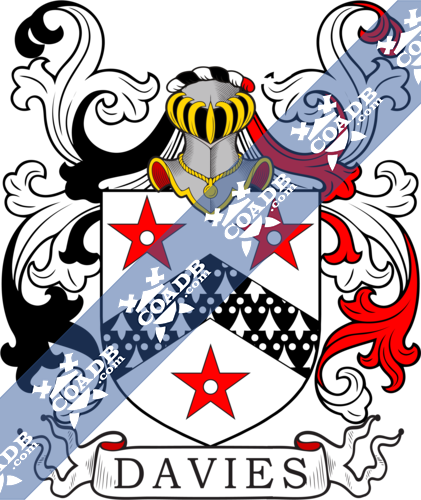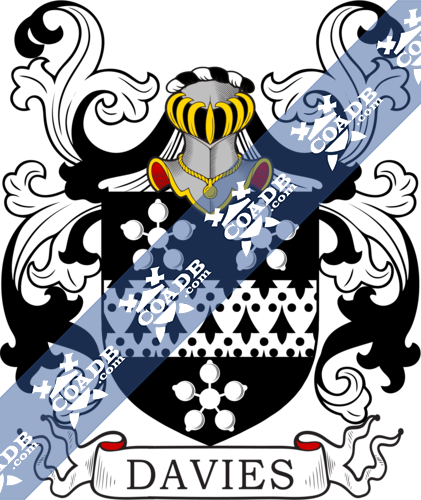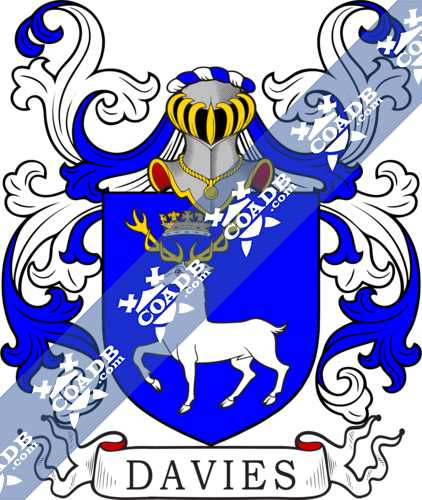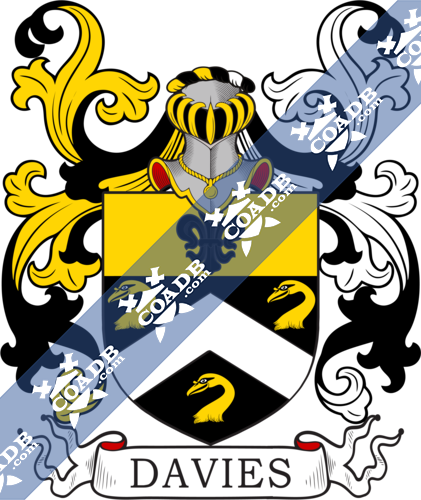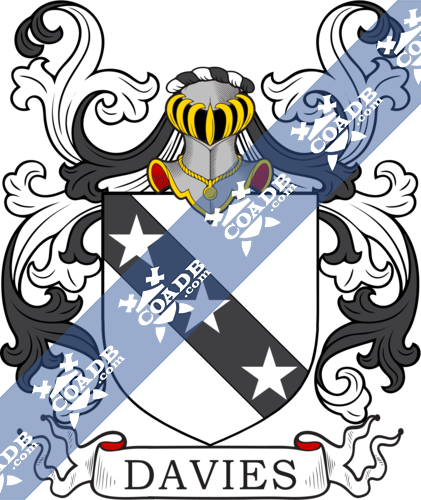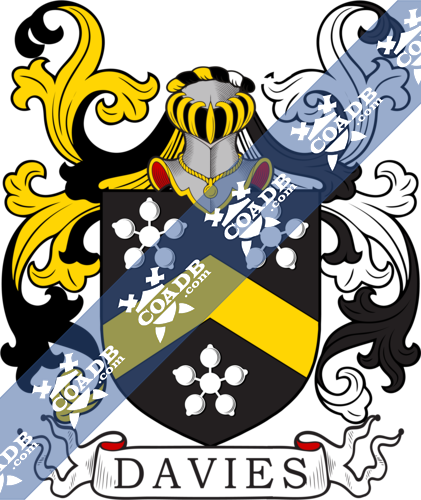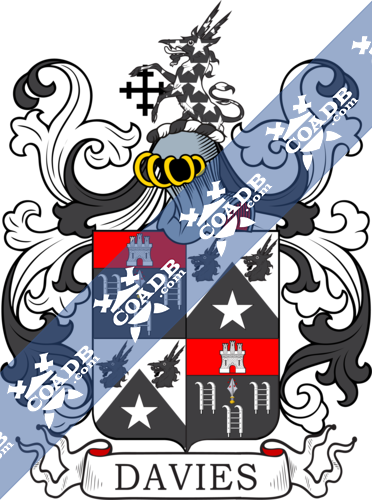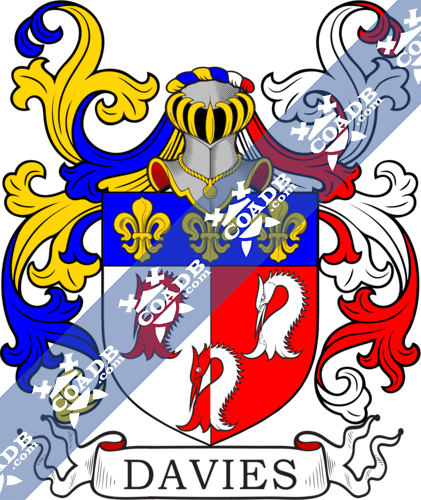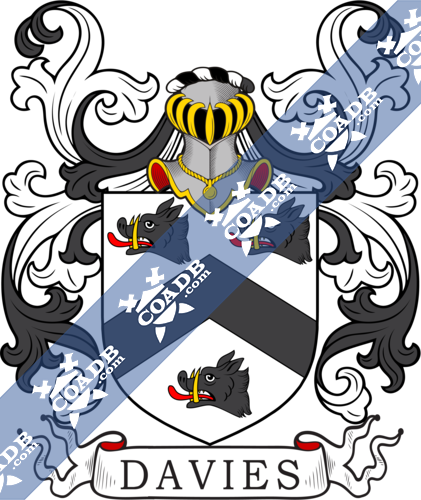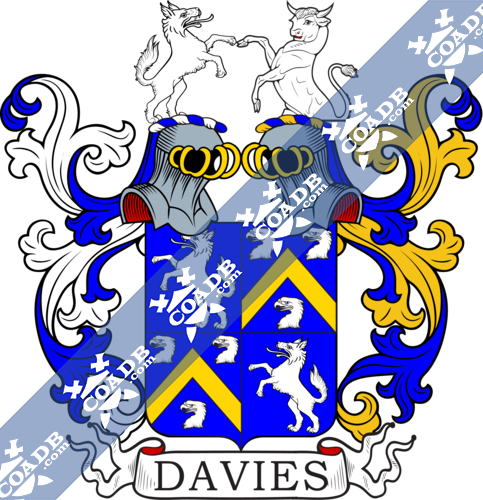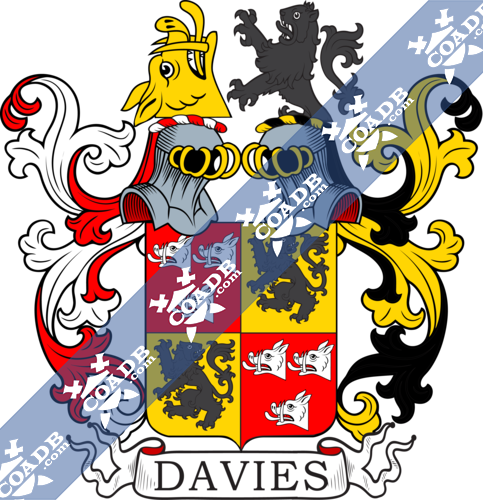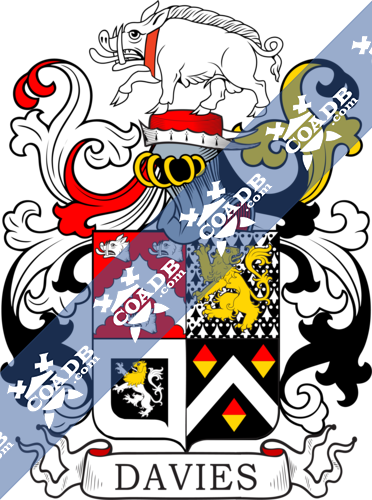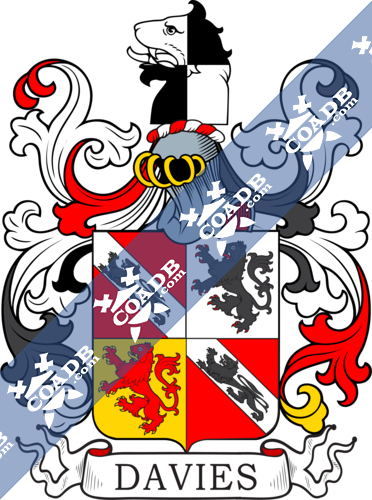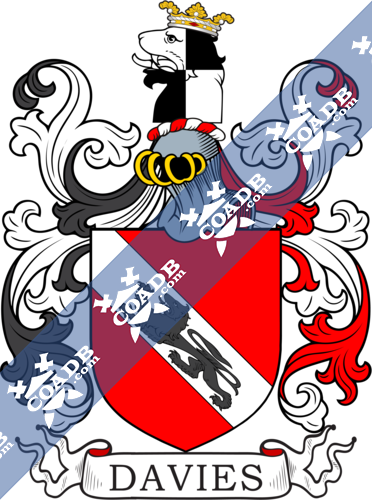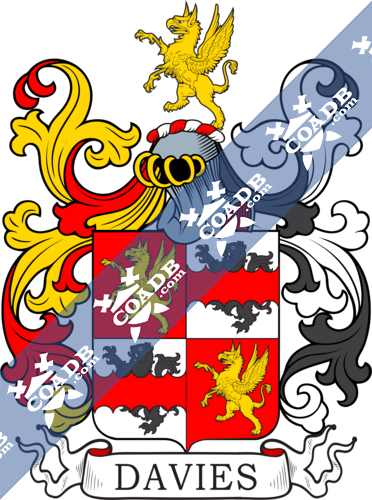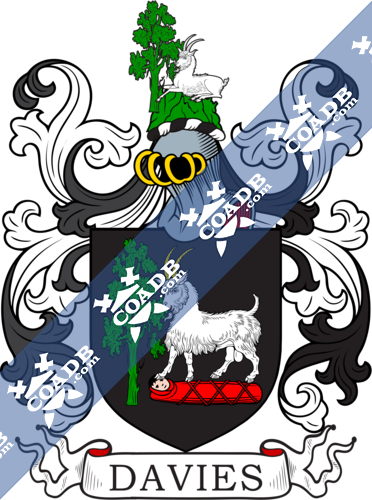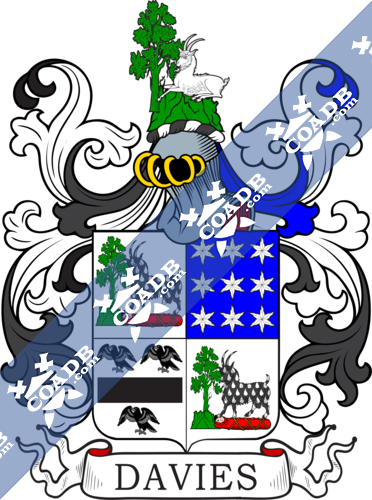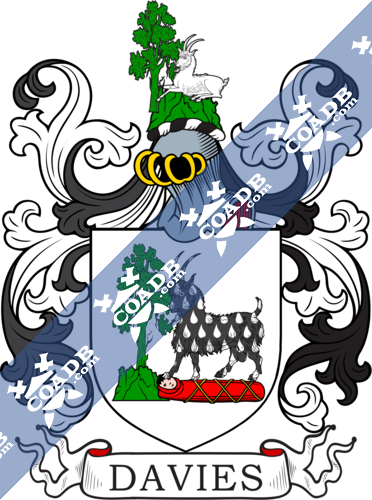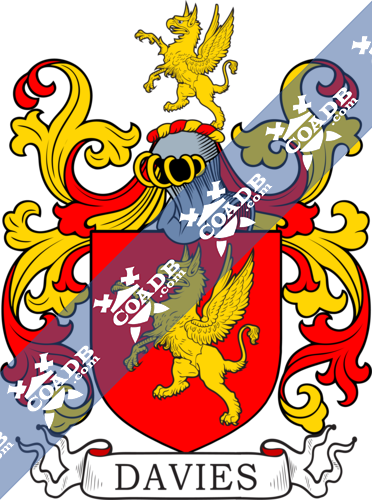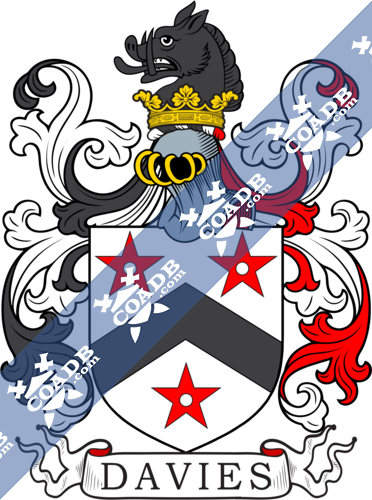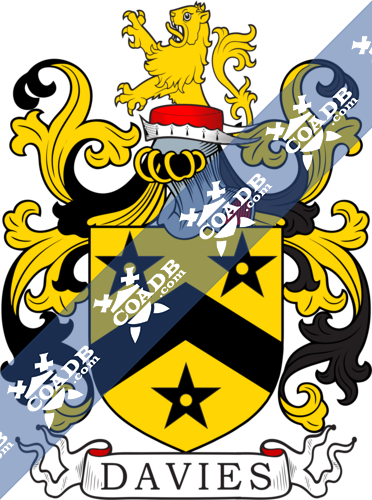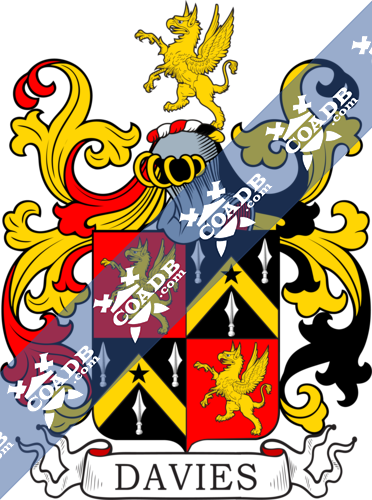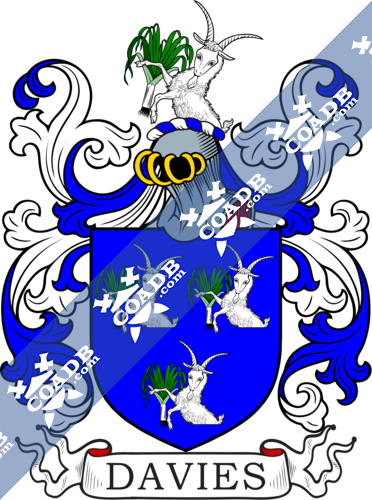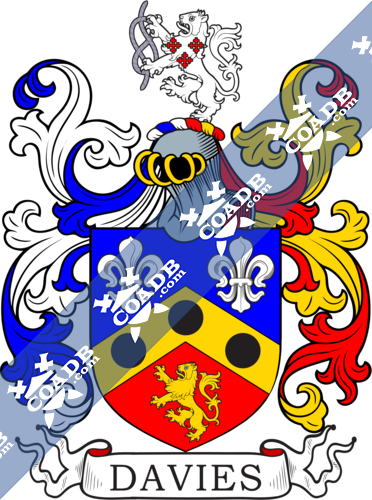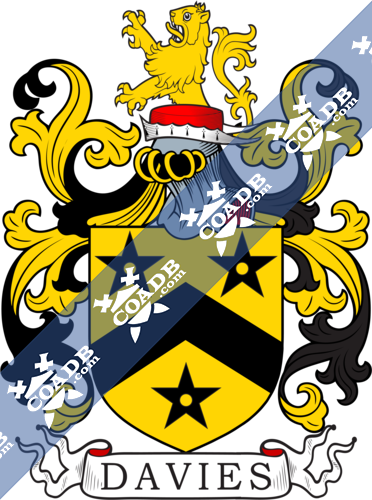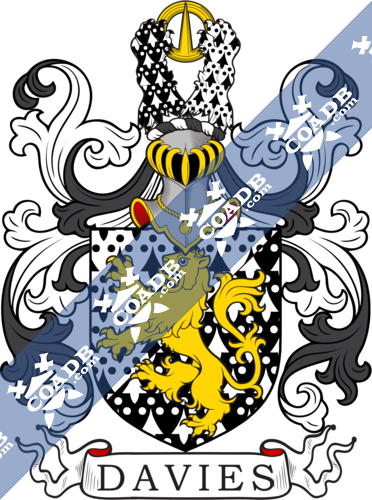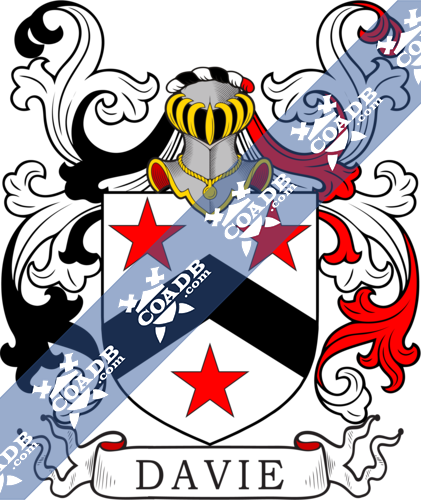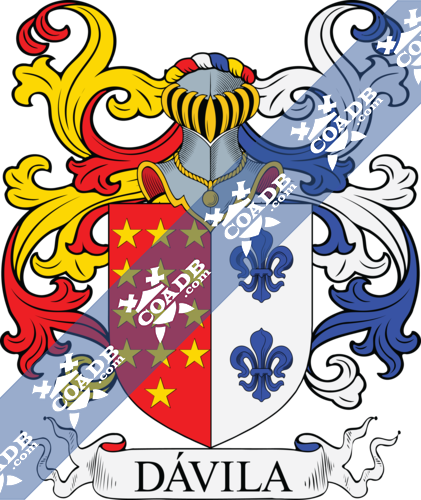Davies Family Crest, Coat of Arms and Name History

Davies Coat of Arms Gallery
Don’t know which Coat of Arms is yours?
We can do a genealogical research. Find out the exact history of your family!
Learn MoreSurname Meaning, Origin, and Etymology
Davies is a surname that comes from the British region of Wales and it began to be used during the middle age. It is a patronymic surname, which means it is derived from the name of the father and it represents the blood relationship between the son and the father. Davies means “son of David” which was a Hebrew personal name that stands for “beloved”. David is a biblical name that became very popular after the Crusades to recover the Holy Land in the 12th century. After the soldiers returned home, they started naming their children after religious figures, in this case, King David of Israel who was famous for adding new territories, like Jerusalem to expand his kingdom.
David was also very popular in Wales thanks to their local Saint Patron, Saint David, who was a bishop from the 6th century. Once these children named David had their own children, the surname Davies started to be used. The oldest seat of this family was located in the county of Flintshire at the north-east of Wales, a county that was created after the fall of the Kingdom of Gwynedd in 1284. The first record of this surname belongs to John Dauisse, who appeared in the Subsidy Rolls of Cambridgeshire, England in 1327, during the reign of King Edward III, which as from 1327 until 1377.
The surname Davies is closely related to the surname Davis, because of the share the same origin. They both are from Wales during the middle era in the 12th century, they are derived from the personal name David, both means “son of David”, and they became very popular because of the same religious reason. Although they are very similar, they must never be confused, because they are two different surnames, with histories that are completely unique and with were carried by different families through history.
There is an ancient myth that the Davies surname comes from mediaeval archers who used to flash their two fingers at the enemy, whilst chanting Dau fis (Welsh for two fingers), to taunt them. The origin of the myth goes like this: “This salute dates back to the English Longbowman who fought the French during the Hundred Years War (1337 – 1453). The French hated the English archers who used the Longbow with such devastating effect. Any English archers who were caught by the French had their Index and middle fingers chopped off from their right hand- a terrible penalty for an archer. This led to the practice of the English archers, especially in siege situations, taunting their French enemy with their continued presence by raising their two fingers in the ‘Two-Fingered Salute’ meaning “You haven’t cut off my fingers !”” There is no proof or recording of this myth/folklore and even the BBC give this etymology. Huzzah!” It does appear to be an ancient myth/folklore that has been passed down through history as a romanticized story of the archers, although I have to admit it is a great one.
Spelling Variations
The spelling variations of the Welsh surnames are a perfect example of why this phenomenon occurred. After the people from Wales started to use surnames, they were translated into English, so they could become part of the English society. However, this presented a problem, because most of the words of the Welsh language couldn’t be adapted perfectly to English, thanks to phonetic reasons so, there was a lot of confusion and many translations mistakes. Some Welsh families made changes to their surnames, like adding suffixes or prefixes, to show a particular loyalty or religious tendency, this was a regular practice during the middle age.
The evolution of languages also caused several spelling variations, as well as the lack of grammatical rules for many languages, there were even some languages that didn’t have a written format. Because of this, most scribes base their writing on the sound of words, but this led to that every scribe could have his own way of writing, so more spelling variations were created. In the case of the Welsh surname Davies, some of the spelling variations were Davies, Davis, Divis, Davie, and other very different like Dauisse.
Popularity & Geographic Distribution
Even when Davies was a very popular surname in Wales during the middle age, it didn’t spread across the world. Actually, it wasn’t very popular in England, especially in the north of the country and also to the east, where there weren’t almost any trace of it. It had the same behavior in the rest of Europe. Is that so, that it holds the 1,105th position in the ranking of popularity of the surnames in the world and it only has approximately 479,151 bearers. They country with the biggest amount of bearers of Davies is England, followed by Nigeria on second place and Wales in third. The highest density of Davies is in Wales. All of this data is taken from the census of 2014.
Early Bearers of the Surname
There are good records that show some old bearers of the surname Davies, they appear in numerous documents from different regions. Some of them are Thomas Dayson, who can be found in the Pipes Rolls of Yorkshire in 1327, Richard Davys who is named in the Register of Freemen of the City of York in 1402, Thomas Davies, who was a bookseller and got to be Lord Mayor of London in 1666 and then Master of the Stationer’s Guild in 1668, Francis Davies (1605-1675) who was the Bishop of Llandaff from 1667 until 1675 and Edward Davies (1680-1688) who was a pirate who operated in the Caribbean Sea and led several raids against Panamá and Spanish posts.
History, Genealogy, and Ancestry
Currently, the surname Davies is not very popular, however, this was not always the case. Centuries ago the reality of Davies was different and it had many families that carried it and there are some good records about the genealogy of those families. One of them were the Davies of Elmley, which head of the family was Henry Fanshawe Davies, Esquire of Elmley, and Lieutenant-Colonel of the Grenadier Guards and J.P. of Sussex. He was born on February 17, 1837, and got married to Ellen Christine, who was the second daughter of John Alexander Hanky, Esquire of Balcombe Place and Sussex on August 4, 1863. Their children were Francis John, who was born on July 3, 1864, Henry Rodolph who was born on September 28, 1865, Hugh Warburton who was born on December 26, 1871, Christine Isabel, Mary Elizabeth, Lucy Cecil, Mary Elizabeth and Margaret Anne.
The original seat of this family was located in Montgomeryshire, where they lived for several centuries in Marsh, Salop. The lineage of this family began with Thomas Davies, Esquire and Advocate-General of Calentta, he was the first son of Thomas Davies, Esquire of New House and his wife Mary Warburton. Thomas Davies was born on November 9, 1751, and got married on April 3, 1788, to Anna Bailie, the first daughter of Hugh Bailie, Esquire of Monckton. Thomas and Anna had three children, the first one was Thomas Henry Hastings of Elmley Castle, who grew up to became a Colonel in the army and M.P. of Worcester, he was born on January 27, 1789, and on January 17, 1824, got married to Augusta Ann, daughter of Thomas C. De Crespigny. Thomas Henry Hastings died and left no children.
The second child of Thomas and Anna Bailie was Warburton of Woodgate, Sussex who was born on January 29, 1790, and on December 21, 1821, got married to Sophia, daughter of Sir James Bland Burges of Beauport. They had two children James Henry in 1822, who died in 1866 without children and Charles who was born on August 12, 1792, and died in 1806.
The third child was Francis John Davies of Danehurst, Sussex, who was born on May 1791 grew up to be a General in the army. He got married twice, the first time to Anne Dunlop, daughter of General James Dunlop on May 5, 1824. She died on April 9, 1825, and then he got married to Elizabeth, daughter of Admiral Sir Thomas Byam Martin on July 17, 1834. His children were Francis Byam, who was born on June 3, 1835, and became a Lieutenant of the Green Guards and, he died on November, 10, 1854 thanks to have been wounded in battle on October 19, 1854, Henry Fanshawe, now of Elmley, Hugh, who was born on November 4, 1839 and died on June 17, 1841, Byam Martin who was born on October 1, 1840, Barrister-at-Law and got married to Frances Anna, daughter of Edward Conant, Esquire of Lyndon, Rutland on September 21, 1874, Catherine Anne and Charlotte Elizabeth.
The coat of arms of this family consisted in a silver color in the background with a goat standing on a child in a cradle, while it is feeding on an oak tree on a mount. The crest is formed by a mount vert a goat lodged against an oak tree. The particular motto of this branch was “Deus tuetur” which means “God protects”.
The Davies of Croft Castle, Wigmore Hall, and Wellington were another branch of the surname Davies and their head of the family was Kevill-Davies of Croft Castle, Wigmore Hall and Wellington who was born on July 21, 1826. On November 24, 1845, he got married to Ellen Martha, daughter and co-heir of Solomon Richards, Esquire of Solsborough. Their children were William Trevelyan Somerset, who was born on December 30, 1847, and got married to Annie Richardson Lily, daughter of Mr. Serjeant Armstrong in 1875 and had a son named William in 1877. The second child was Somerset Edward O’Brien who was born on May 25, 1851, then there were Henry Bateman Richards, who was born on August 15, 1852, Edward Langham Boughton, who was born on October 22, 1853, Albert Sidney Goodriche, who was born on July 18, 1855, Ellen Isabella who got married to Denis Maurice O’Connor in 1873, Augusta Catherine and Eva Maude Mary.
A third line of the surname Davies is formed by the Davies of Moor Court, who were represented by Reverend James Davies, who was born in 1820 and in 1847 got married to Frances Helen, the only daughter of Abraham Henry Young, Esquire of Cowbridge House, Wilts. The children of James and Frances were: James Henry, J.P. who was born on June 7, 1850, and got married to Mabella Elizabeth, daughter of Colonel A. Longmore on April 19, 1876, and they had a son named James Henry Longmore who was born on March 30, 1877. They second child o James and Frances was Hugh Powel who was born on May 21, 1853, then there were Richard Banks, who was born on September 23, 1860, William Philip Banks, who was born on January 21, 1867, Esther Frances, Alice Mabel, Mary Helen, Frances Marian, who got married to Frederick Roger Tidd Pratt, Esquire of Kington on April 27, 1876, Margaret Banks, Emily Banks, Edith Banks and Phillis Banks. The coat of arms of this family was dived in four sections, the 1st and 4th had a griffin segreant for Davies and the 2nd and 3rd had a lion rampant with a fess over the whole shield for Powell. In the crest there was a griffin sergeant.
Another branch of Davies was the Davies of Alltyr Odin, who were represented by John Davies-Lloyd, Esquire of Alltyr Odin who was born on October 30, 1850. This family began with John Lloyd Davies who was a descended of David ap Llewellyn of Castle Howell. He was born on November 1, 1801, and got married to Anne John Lloyd, Esquire of Alltyr Odin on June 30, 1825. They had a child named Arthur Lloyd Davies on January 6, 1827, who got married on December 11, 1849, and then died in 1852. He only had two children, John Lloyd Davies and Anne Justina who got married to Haworth Peel Massy in 1873. The coat of arms of this family was divided into four quadrants, the 1st and 4th for Lloyd with three scaling ladders and a spearhead nailed on a castle and the 2nd and 3rd quadrants for Davies with a chevron and the heads of two antelopes on a base. The crest was a demi-antelope of mullets that holds between its legs a cross-crosslet. This branch of Davies counted on two mottoes “Byddd gyflawn, bydd lwyddiannus” which means “Be just, be prosperous” and “Sic itur ad astra” which means “Such is the way to immortality”.
A fifth line of the surname Davies are the Davies of Pentre, who were represented by Arthur Picton Saunders Davies, Esquire of Pentre, he was born in 1862. The seat of this family was at Llandovery. Arthur Davies of Llandovery was a son of Rhys Davies and got married to Anne Morgan, daughter of Jenkin Morgan. The child of Arthur and Anne was David Davies who got married to Susannah Saunders, daughter and heiress of Erasmus Saunders, Esquire of Pentre. Arthur and Susannah had three children David Arthur Saunders, the heir, Jane Anne Bridget who got married to Reverend Augustus Brigstocke, son of William Owen Brigstocke, Esquire of Blaenpant and Catherine Angharad who got married to William Webley Parry, son of Admiral Webley Parry.
The heir David Arthur Saunders Davies, became the Esquire of Pentre and J.P of Carmarthenshire. He was born on June 9. 1792 and on July 31, 1826, got married to Elizabeth Maria Philipps, daughter of Colonel Owen Philipps of Williamstown. David and Elizabeth had the following children, Arthur Henry Saunders, Owen Gwyn Saunders who was born on May 14, 1834, and got killed in Crimea, Henry David Saunders, who was born on January 6, 1836, Susan Maria Anne who got married to Janes John Lloyd and Agnes Elizabeth.
David Arthur Saunders was succeeded by his eldest son, Arthur Davies Saunders, who became the Esquire of Pentre. Arthur was born on April 22, 1832, and on March 31, 1860, he got married to Fanny Philipps, daughter of Grismond Philipps, Esquire of Cwmgwilly and their children were: Arthur Pictor Saunders, now of Pentre, David Grismond Owen Saunders who was born in 1863, Henry Gwyn Saunders who was born in 1865, Herbert, John Saunders, Edwin Lewes Saunders, Frances Augusta Maria Saunders, Agnes Catherine Elizabeth Saunders and Cecil Mary Saunders. Arthur Henry Saunders died on June 8, 1873. The coat of arms of this family was formed by 4 quadrants, in the 1st and 4th there was a salient wolf for Davies and on the 2nd and 3rd, there was a chevron between three eagle’s heads from Saunders. The crest was a silver salient wolf for Davies and a demi-bull couped at the loins for Saunders. The motto of this family was “Solem ferro” which means “Sun of steel”.
Early American and New World Settlers
The arrival of Christopher Columbus in America marked the beginning of the voyages of many Europeans to the new continent. They were looking for a new and maybe a better life, but they didn’t only bring their hope and dreams, they also brought their cultures, traditions, and surnames. This was how the last names from the old continent got to America.
This arrival occurred across many years, even centuries. Some of the bearers of Davies who got to America in the region of Virginia during the 17th century were Edward Davies, Samuel Davies, and Walter Davies who arrived in 1622 and Samuel Davies and Nicholas Davies who did it in 1623. This movement of people continued during the 18th century with William Davies who arrived in Virginia in 1705, Mary Davies who also landed in Virginia in 1719, Thomas Davies who arrived in New England in 1761, Henry Davies who got to America in 1764 and David Davies who arrived in Mississippi in 1799.
In the 18th century more bearers of Davies landed in the US, such as Rowland Davies who arrived in New York in 1821, John Mayer Davies who also landed in New York but in 1822, Robert Davies who got to Indiana in 1831, Gwenelly Davies who landed in Maryland in 1838 and Daniel Davies who arrived in Pennsylvania in 1842.
Not all the first bearers of Davies in traveling from Europe to America arrived in the United States. Canada was also a favorite place for Europeans to start a new life. Some of the bearers of Davies in arrived in Canada during the 18th century were Mr. Benjamin Davies U.E. who got to Ontario in 1784, Mr. Peter Davies U.E. who also arrived in Ontario that same year, 1784 and that was also the year in which Mr. Walter Davies U.E. and Mr. William Davies U.E. also arrived in Ontario. The initials U.E. on their names stands for “United Empire”, this was a way to show that they kept loyal to the crown of England during the Independence Revolution of the United States, so they had to leave that country.
During the 19th century, more bearers of Davies arrived in Canada such as Ann Davies, who arrived in Nova Scotia in 1818, John Davies who landed in New Brunswick in 1833, Thomas Davies who also arrived in New Brunswick but in 1834 and another John Davies who did the same in 1838. In the 20th century, E. E. Davies and William Davies arrived in New Brunswick in 1907.
Mottoes
Mottoes were phrases used by families to express something in which they believed, like a religion, a moral code or a how they lived life. I could also express to whom they were loyal or also could be a battle cry. Some families were so attached to their mottoes that hey integrated to their coat of arms. The most famous mottoes of families that were bearers of the surname Davies are:
- “Benigno Numine” which means “By benign Providence”.
- “Coeptis aspirate meis” wich means “Be favorable to my undertakings”.
- “Deus tuetur” which mens “God defends”
- “Dum spiro spero” which means “While I have breath I hope”.
- “En Dieu est tout” which means “In God is everything.
- “Heb Ddux heb ddim, Duw a digon” which means “Without God without anything, God is enough.
- “Honor virtutem coronat” which means “Honor crowns virtues”.
- “Invidere sperno” which means “I scorn to envy”.
- “Sic itur ad astra” which means “Such is the way to immortality”.
- “Solem ferre possum” which means “I can bear the sun”.
- “Toraf cyn plygaf” which means “I´ll break before I´ll bend”.
- “Virtude duce, comite fortuná” which means “With valour my leader and good fortune my companion”.
- “Per crucem ad castra” which means “Through the cross to the camp”.
Grantees
Some of the grantees of the surname Davies were: John Davies of Middleton son of John, crest on December 24, 1623, Thomas Davies who was a barber from Wales who got married on December 1, 1664, and Sir Thomas Davies of London in 1677.
Notables
Although nowadays Davies is not a surname with a high popularity, it has some bearers that have played an important role in different areas such as acting, politics, and sports. Some of the most important are: Aaron Michel Davies (b. 1984) an American actor, Caitlin Davies (b. 1964) an English writer, Bevan Davies an American drummer who has played in several rock bands, Dick Davies (1936-2012) an American basketball player who was part of the Olympic team, Eva Davies (1924-2013) a British fencer, Freddie Davies (b. 1937) English comedian, Godfrey Davies (1892-1957) an English historian, Marcus Davies (b. 1991) an Australian football player, Philip Davies (b. 1972) a British Conservative politician, Emlyn Davies (1922-2016) a Welsh rugby player who was part of the Wales National Team from 1947 until 1948, William Henry Davies (1871-1940) a Welsh poet author of “Autobiography of a Super-tramp”, and David Davies (1880-1944) a philanthropist from Wales.
Blazons & Genealogy Notes
1) (co. Brecon). Ar. a dragon’s head and neck erased vert, holding in the mouth a bloody hand.
2) (co. Brecon). Az. a stag pass. ar. attired or, betw. the attires a regal crown ppr.
3) (granted to John Evan Davies, Esq., of the city of Bristol). Az. three demi goats guard, ar. each holding in the paws a leek ppr. Crest—A demi goat as in tho arms.
4) (John Birt Davies, Esq., Birmingham). Per chev. az. and gu. on a chev. or, betw. two fleurs-de-lis in chief ar. and a lion ramp. in base of the third three pellets sa. Crest—A lion ramp. ar. charged with three cross crosslets gu. and holding betw. the paws a piece of cable nowed ppr. Motto—Conatimur.
5) (Kent). Quarterly, 1st and 4th, gu. three boars’ heads couped ar.; 2nd and 3rd, or, a lion ramp. reguard. sa. Crests—1st: A boar’s head couped and erect or; 2nd: A demi lion ramp. sa.
6) (Sir Thomas Davies, Lord Mayor of London 1677). Or, a chev. betw. three mullets pierced sa. Crest—On a chapeau ppr. a demi lion ramp. or.
7) (London and Shropshire). Per bend sinister erm. and ermines a lion ramp. or. Crest—Two lions’ gambs erased, the dexter ermines, the sinister erm. holding a buckle or.
8) (Bishop of St. Asaph, 1560-61, and St. David’s, 1561-81, translator of part of the Bible into English, and of part of the New Testament into Welsh, derived from Ednowain Bendew). Per pale ar. and gu. three pelicans’ heads in piety counterchanged, on a chief az. three fleurs-de-lis or.
9) (Rev. John Davies, D.D., Mall-wydd, author of the Welsh Grammar and Dictionary, and translator of the Thirty-nine Articles into Welsh, derived from Marchud ap Cynan). Arms, those of Ednowain Bendew.
10) (Prittlewell). Quarterly, 1st, gu. a chev. engr. betw. three boars’ heads erased ar.; 2nd, per bend sinister erm. and sa. a lion ramp. reguard. or.; 3rd, sa. a lion ramp. ar. maned or, within a bordure of the second; 4th, sa. a chev. ar. betw. three lozenges per fesse gu. and or. Crest—On a chapeau gu, turned up erm. a boar pass. ar. collared of the first.
11) (Gwysaney, co. Flint, derived from Cynric Efell, Lord of Eglwys Egle, son of Madoc, last Prince of Powys-Fadoc). Quarterly, 1st and 4th, gu. on a bend ar. a lion pass. sa., for Davies; 2nd, ar. a lion ramp. sa. armed and langued gu., for Madoc ap Meredith, last prince of Powys; 3rd, or, a lion ramp. gu., armed and langued of the first, for Bleddyn ap Cynfyn, King of Powys. Crest—A lion’s head couped quarterly ar. and sa., granted to Robert Davies, Esq., of Gwysaney, 20 April, 1581, when the arms were confirmed. Motto—Heb Dhuw heb ddym, Dhuw a digon.
12) (Kellio and Kea, co. Cornwall). Sa. a fesse or, betw. three cinquefoils ar.
13) (Tredrca, co. Cornwall). Ar. a chev. ermines betw. three mullets pierced gu.
14) (Hanwell, co. Middlesex). Gu. on a bend ar. a lion pass. sa. Crest—A lion’s head couped quarterly ar. and sa. ducally crowned or. Motto—Honor virtutem coronat.
15) (Pentre, co. Pembroke). Quarterly, 1st and 4th, az. a wolf saliant ar., for Davies; 2nd and 3rd, az. a chev. or, betw. three eagles’ heads erased ar., for Saunders. Crest—1st, Davies: A wolf saliant ar.; 2nd, Saunders: A demi bull saliant couped at the loins ar. Motto—Solem ferre possum.
16) (Moor Court, co. Hereford; as borne by James Davies, Esq., of that place, a magistrate for the county). Quarterly, 1st and 4th, gu. a griffin segreant or, for Davies; 2nd and 3rd, ar. a lion ramp. sa. over all a fesse engr. gu., for Powell. Crest—A griffin segreant or.
17) (Tisbury, co. Wilts). Sa. a fesse erm. betw. three cinquefoils ar.
18) (Marsh, co. Salop; originally settled in co. Montgomery). Sa. a goat ar. attired or, standing on a child ppr. swaddled gu. and feeding on a tree vert. Crest—On a mount vert a goat lodged ar. against a tree ppr.
19) (Elmley Park, co. Worcester). Quarterly, 1st and 4th, ar. a goat sa. guttee d’ean, standing on a child ppr. in a cradle gu. swaddled or, and feeding on an oak tree upon a mount vert, for Davies; 2nd, az. nine estoiles ar., for Baillie; 3rd, ar. a fesse couped betw. three ravens rising ppr., for Pierce. Crest—On a mount vert a goat lodged ar. against an oak tree ppr. Motto—Deus tuetur.
20) (Clovenshannogh, co. Roscommon, Reg. Ireland). Same Arms, without the quarterings.
21) (Thicknam, co. Somerset). Gu. a griffin segreant or. Crest—A griffin, as in the arms.
22) (co. Stafford). Sa. a chev. ar. betw. three swans’ necks or, on a chief of the third a fleur-de-lis of the first.
23) (Vine Hall, co. Sussex). Ar. a chev. sa. betw. three mullets gu. pierced or (another, pierced of the field). Crest—On a ducal coronet or, a boar’s head couped sa.
24) Ar. on a bend sa. three mullets of the field.
25) Sa. a chev. or, betw. three cinquefoils ar.
26) (Sir Thomas Davies, 1677, Lord Mayor of London). Or, a chev. betw. three mullets pierced sa. Crest—On a chapeau ppr. a demi lion ramp. or.
27) (Davies-Lloyd) (Arthur Lloyd Davies-Lloyd, Esq., of Blaendyffryn, was authorized by royal licence, 31 Jan., 1848, to add to his patronymic the surname of Lloyd, and to quarter, with his paternal coat, the arms of his mother’s family, under the will of David Lloyd, Esq., of Alltyr Odin, his maternal grand-uncle). 1st and 4th, Lloyd, sa. three scaling ladders ar. in chief a spear head embrued ppr. on a chief eu. a castle of the second; 2nd and 3rd, Davies, per chev. ar. and sa. in chief two antelopes’ heads erased of the second, in base a mullet of the first. Crest—A demi antelope sa. semed of mullets ar. holding betw. the legs a cross crosslet sa. Motto—Sic itur ad astra.
28) (Ticknam, co. Somerset; Rees Davies, Esq., of Ticknam, temp. James I., son of Lewis Davies, Esq., of Carmarthen, who was great-grandson of William ap David, third son of David ap Ievan ap Rees, and brother of Llewellen, of Keven Metgoed, ancestor of the House of Gwydir. Visit. Somerset. 1623;. Gu. a griffin segreant or, quartering, sa. a chev. or, betw. three spears’ heads ar. a mullet for diff. Crest—A griffin segreant or.

